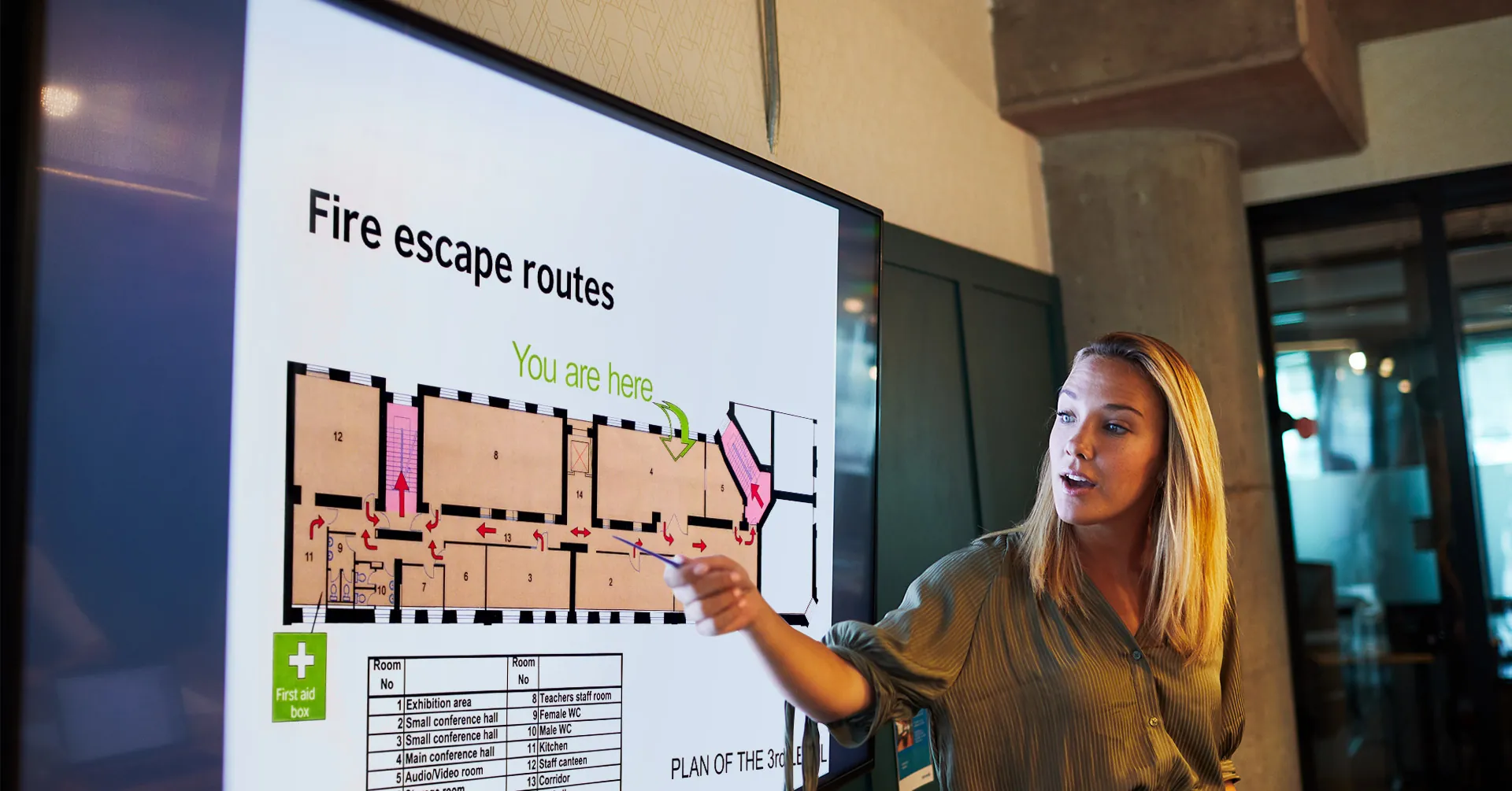
How to Create an Emergency Evacuation Plan [+ Template]
In today’s threat landscape, you need a trained evacuation response without confusion or uncertainty from a lack of planning. Learn how to use an emergency evacuation plan template to ensure you can keep your people safe when every second counts.
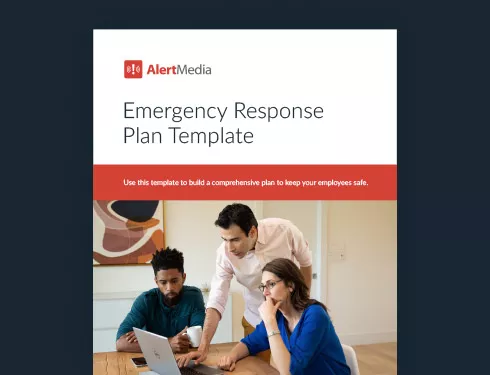
“When the fire alarm rings, nobody runs to the wall and looks at the evacuation map,” explains JoAnn Dankert, Senior Safety Consultant at the National Safety Council. Joann shared her insights on The Employee Safety Podcast. “We want to have the procedures embedded into our memory, and you want more than one way to exit the building or location.”
With an emergency evacuation plan template, it’s easy to build an evacuation plan you can practice so your team will have a safe response imprinted in their minds and muscle memories. That way, when they go into survival mode, they don’t forget things in the rush. When you train your team in emergency evacuation protocols, you reduce the delay, hesitation, and misguided actions that could put your people at risk of injury or even death. You can create your plan in just a few steps to start practicing and get your team ready to respond safely to the next emergency.
Download Our Emergency Response Plan Template
Why use an emergency evacuation plan template?
Using a template to build out your emergency evacuation plan is the best way to ensure you’ve prepared everything you need for a smooth evacuation. It takes the guesswork out of what information or resources you need to collect and provides a single place to document your emergency response procedures.
9 Steps to Build Your Emergency Evacuation Plan
Here are the nine steps it takes to develop your building emergency evacuation plan using a template. Download a free template here to get started with a thorough emergency plan.
1. Find your potential evacuation risks

First, assess your risks and gather relevant details about the potential hazards that may lead to an evacuation response. Your effective evacuation plan must account for different hazards and emergency scenarios. For example, you might need to run a fire evacuation differently than a flood or chemical spill. The specific type of emergency will determine your response steps, so start your emergency evacuation plan with a business threat assessment to analyze the risks thoroughly.
Potential reasons for an evacuation:
- Fires
- Bomb threats
- Emergency situations
- Natural disasters (hurricanes, tornadoes, floods, etc.)
- Workplace violence/active shooter events
- Suspicious package threats
- Severe weather
- Gas leaks
- Medical emergencies (medical evacuations)
- Hazardous materials/chemical spills
Special considerations
Depending on your industry, operational capacity, or even the day, there will be slight variations in your emergency evacuation. Those variations should be considered when you build out your plan rather than in the moment during the emergency. Here are a few things you might want to consider when building your plan:
- Will there be customers, clients, or members of the public in or around your business?
- Do you have any mobility-impaired employees or anyone with disabilities?
- Are there any evacuation routes that are likely to be blocked?
- Do you have a secondary assembly location?
2. Determine your evacuation routes
Next, map out your evacuation routes. Your escape routes should be the quickest and safest ways out of the building or job site. There should be ample room for building occupants to move through the route, and it should be clear of obstacles at all times. If you are evacuating multiple floors, use stairwells rather than elevators, which may create delays and even malfunction and trap people in the very place they are attempting to evacuate. Consult with building management to determine the fastest and safest ways out of the building.
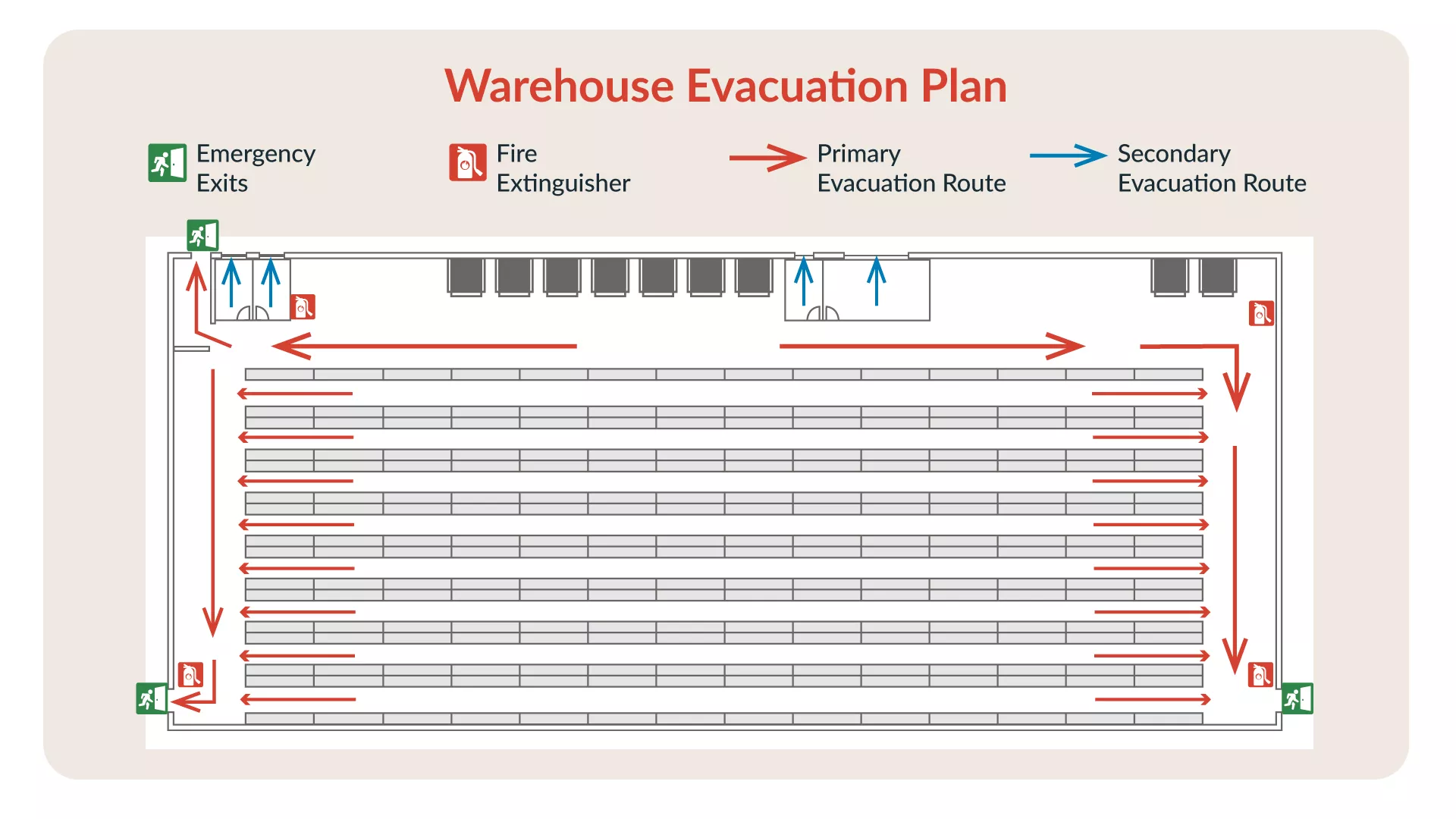 Sample warehouse evacuation plan
Sample warehouse evacuation plan3. Chose an assembly point
Identify a safe assembly point for employees to gather outside of the building. This assembly point should be at least 500 feet away from the threat. There should be plenty of space for everyone to gather so you can perform a head count and double-check that everyone got out safely.
For specific emergencies where evacuation might be interrupted by the need to shelter in place, such as with an active shooter event, identify multiple areas of refuge where people can wait safely until their path is clear again.
Evacuation preparedness supplies to have on hand
- Fire extinguishers/fire sprinklers
- First aid kit
- Contact information
- Emergency action plan documents
- Emergency supply kits (water, blankets, batteries, etc.)
4. Post evacuation maps
Once you have your exit routes and assembly point, create a visual map of the evacuation routes using your specific floor plan that shows where people should go. Mark stairwells, egress doors, emergency exits, and areas of refuge, and mark the route clearly on the map. Then, post these maps in common areas across your facility. Break rooms, common spaces, and frequented hallways are good places to post them since they are easy to access.
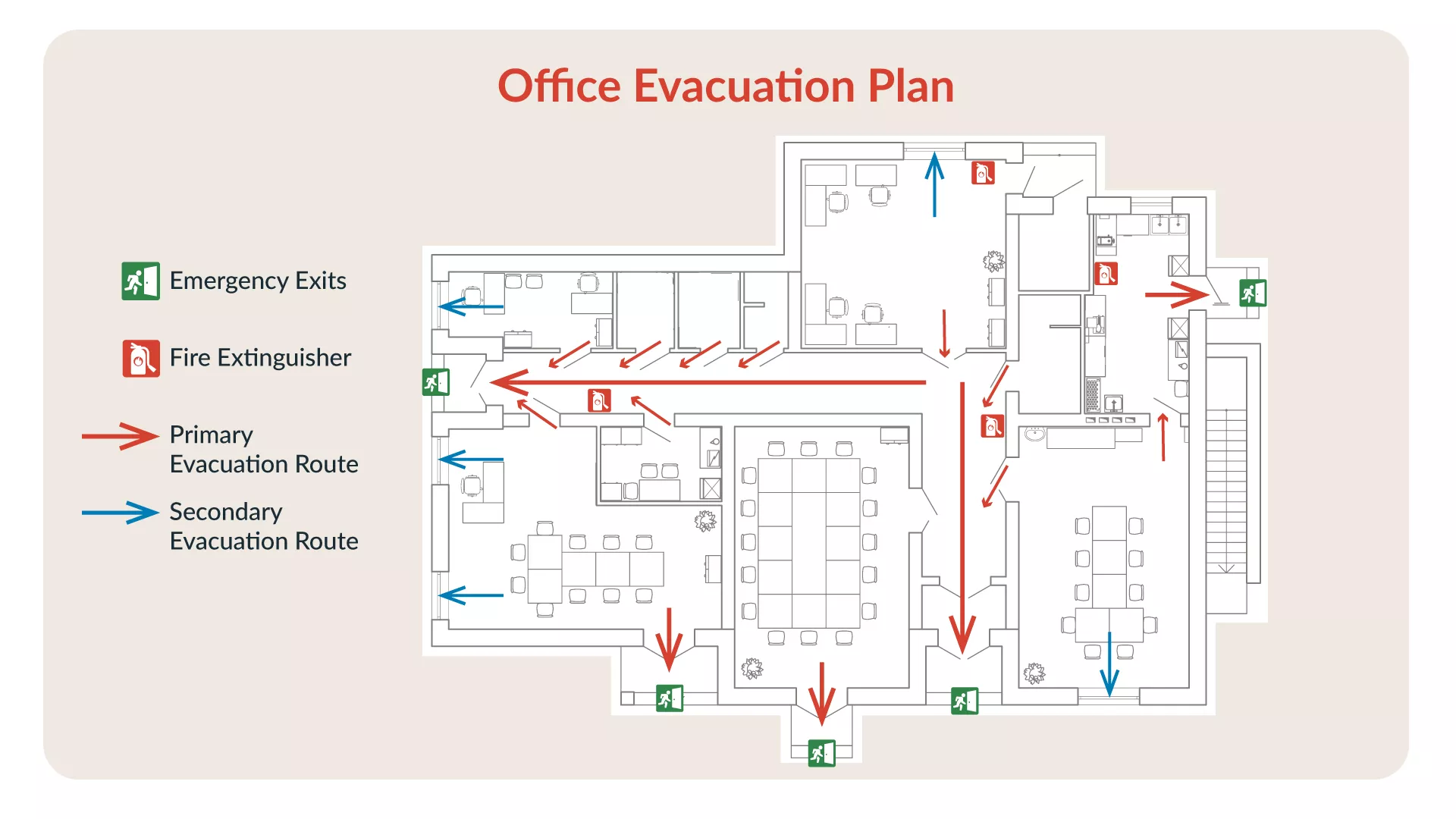 Sample office evacuation map
Sample office evacuation map5. Document the evacuation procedures
The next step is to document your emergency evacuation procedures. This plan should clearly explain what to do in a step-by-step process to evacuate safely. Here is an example of some steps you might include.
When you hear the fire alarm or evacuation order:
- DO NOT stop to gather personal belongings
- Proceed immediately to the nearest evacuation route, closing doors behind you
- Convene at the designated assembly point for head count
- Respond to wellness/safety survey
- Follow instructions from the evacuation safety warden regarding return to work
Remember, your instructions should be clear enough to understand and remember during a high-stakes situation. You want important details, but not so much that the instructions become confusing.
6. Create a communication plan
A critical piece of your evacuation plan is communication. If you don’t communicate that there is an emergency, nobody will know to evacuate. You need to be able to get the word out to team members, customers, clients, or anyone who might be impacted on site. Take time to write out an emergency communication plan covering the entire evacuation process, from the moment the emergency starts to operations returning to normal. That end-to-end plan might look like this:
- Inform safety leadership/incident commander of the emergency event
- Send out an alert to the impacted group
- Call 9-1-1 and/or the fire department
- Remind affected groups of the evacuation instructions
- Remind impacted groups of the assembly area
- Send out contingency plan information if the situation changes
- Send out a wellness survey to check if everyone is safe
- Alert first responders/emergency personnel of anyone still at risk
- Communicate with company leaders about event status
- Communicate with family members or emergency contacts of the impacted group if necessary
- Inform the impacted group of the recovery steps
- Give the all-clear to return to the building
One way to streamline your communications plan is to use communication templates. Pre-building your emergency communications means you don’t have to spend precious seconds typing out long messages. You can simply copy and paste the generalized message and add in pertinent details of the specific event. Here are a few examples of notification templates you might use for different emergency evacuations.
Notification template examples for an emergency evacuation
Fire—Email template** FIRE REPORTED – EVACUATE IMMEDIATELY ** This is NOT a drill! A fire has been reported in the [DESCRIPTION] section of the [LOCATION] office. Please evacuate the building immediately. Do not use elevators. If the nearest exit is blocked by fire, heat, or smoke, use an alternate exit. Once outside, stay back from entrances, check in at the designed assembly area, and await further instructions. Contact [CONTACT NAME AND PHONE] if you need immediate assistance. |
Flood—Text/push notification templateALERT – Flooding reported in [LOCATION] due to [DESCRIPTION]. Anyone in [LOCATION], please evacuate immediately following standard evacuation procedures. Reply to this message if you need any assistance. |
Active shooter event—Phone call templateActive shooter reported in the [LOCATION] office. This is NOT a drill! Please evacuate the building immediately. If you are unable to evacuate, hide or resist. |
You’ll also want to make sure you have up-to-date contact information, especially cell phone numbers for all employees and any emergency contacts such as family members. Out-of-date phone numbers might mean you’re sending alerts people will never receive. You don’t want any of your employees left out of the loop in an evacuation notice.
7. Add your contingency plans
If emergencies were predictable, that would make our jobs as emergency managers and safety leaders much, much easier. But complications often arise, and there is likely to be a shift in the situation that requires a change in response. Maybe a gas leak has started a structure fire, or maybe a flood has created even more dangerous structural damage. This is where your contingency plans come in.
Build a list of potential contingency plans you might need to enact if your emergency evacuation changes. You’ll know your contingency risks if you’ve done a thorough threat assessment. You may need to plan for a halt in evacuation that becomes a shelter-in-place, or you may need to stop the use of a particular evacuation route. Clarify in the plan what alternative actions should take place.
Evacuations are for more than just fires
One of the most common reasons for an emergency evacuation is a structure fire. But it isn’t the only reason, and you want to be sure you aren’t limiting your response plans to fire risks alone. Different threats behave and spread in different ways, which means you need to allow for slight variations in your planning. It’s also important to remember that even if your facility has a low risk of fire, you still may have other emergencies that could require an evacuation response, such as active shooter events, gas leaks, or severe weather events.
8. Plan for recovery
An evacuation might end once everyone is out of the building and safe, but your business still needs a plan for where to go from there. You can add recovery planning to your evacuation preparedness. Documenting your recovery steps in advance will give you a place to start getting your business back on its feet. In some cases, recovery may be as simple as sending everyone back to their desks to start working again. But in other cases, there may be necessary facilities work, and there will likely be some crisis communication/PR work if there were public safety risks related to the emergency at your business.
Integrating business resilience into your everyday operations is one way to smooth out your emergency recovery. Business resilience is your organization’s ability to absorb and adapt to changes and work through and around emergencies or interruptions, all while maintaining business operations. It’s not about avoiding all risk; it’s a framework that enables your business to recover quickly and even move forward after a critical event.
“Resiliency is about making sure that we’re able to go forward. Some people talk about resiliency as bouncing back. I don’t want to bounce back. I don’t want to bounce back to where we were before. I want to bounce forward. I want to make sure I have stepping stones in place that I can use to propel over the next situation if I can.”
—Michele L. Turner, Author and Senior Director of Continuity and Resilience, Expedia Group
9. Train your team
Once you’ve documented your plan, you need to train your employees in how to carry it out. This is where it becomes muscle memory. You can start with online training and tabletop exercises to teach your teams the steps and practice their response in theory. But it’s also good to run full-scale emergency evacuation drills so your employees and your emergency response team understand the evacuation plan in practice.
PRO TIP: This is also a great chance to test out your alarm system.
In addition to reviewing the routes and procedures, train anyone who might be sending out evacuation notices to use your emergency notification system. Practice drafting messages and using the system to select which notification channels to use. Practice emergency notifications during your evacuation drill to get a clear picture of how your entire evacuation response works together.
When you send out test messages, your employees get used to seeing emergency messages, so there will be no mistaking a notification for a false alarm or spam message when it really counts. You need everyone to be comfortable with the process from start to finish, so there is no confusion when the scenario becomes real.
If you already have an emergency evacuation plan and are looking to optimize or improve it, these steps can still work for you. Follow each step in this process and make revisions as needed. You can also run an evacuation drill or tabletop exercise and then create an after-action report that documents any gaps in your procedures or steps that are unclear.
Practice Makes Prepared
Quick and confident action comes down to knowing the right steps and practicing before you ever need to perform them in a crisis. With an emergency evacuation plan template, you’ll have one critical element of emergency preparedness accounted for, so you can be confident that your employees are as safe as possible while at work. If you want to level up your evacuation plan and your emergency preparedness as a whole, consider investing in an alert notification system. AlertMedia’s intuitive interface and reliable mass notifications are the best way to keep your employees safe and informed in the event of an emergency.

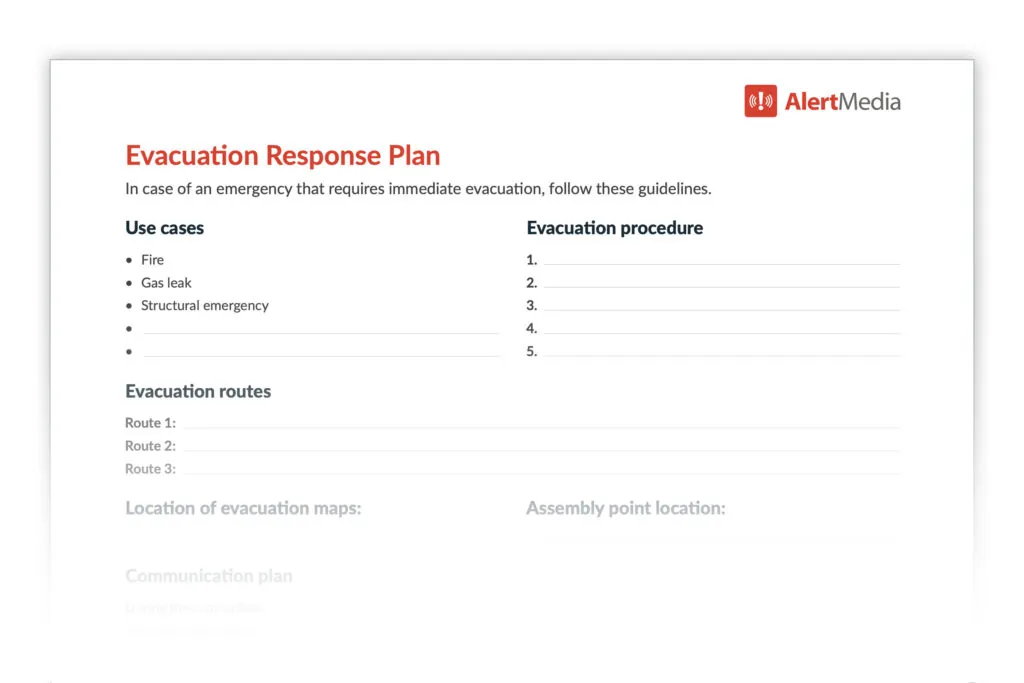

![6 Steps to Creating an Effective Emergency Response Plan [+ Template]](https://www.alertmedia.com/wp-content/uploads/2023/10/Blog-Emergency-Response-Plan.webp)

